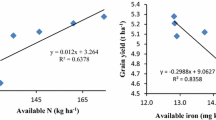Abstract
The influence of different methods of N fertilizer application-sub-surface placement (SS) and broadcast application (BC) as a single basal dose of 40 kg N ha−1 of urea (U) and ammonium sulphate (AS)-on fresh weight (FW) and acetylene reduction activity (ARA) ofAzolla pinnata (Bangkok) and yield of rice was studied for consecutive three seasons. The FW, ARA and N yield ofAzolla were significantly superior with SS placement than with BC application. Of the two N sources, AS was superior to U in recording higher FW, ARA and N yield of Azolla irrespective of methods of N application. Crop yield and crop N uptake were higher with SS application alone and in combination with Azolla as compared to that of surface application of N fertilizers. The combined use of AS and Azolla recorded significantly higher crop yield and crop N uptake than that of U combined with Azolla, irrespective of methods of application.
Similar content being viewed by others
References
Cao Zhi-Hong, De Datta SK and Fillery IRP (1984) Effect of placement methods on flood water properties and recovery of applied nitrogen (15N-labelled urea) in wetland rice. Soil Sci Soc Am J 48: 197–203
Craswell ET and Vlek PLG (1980) Research to reduce losses of fertilizer nitrogen from wetland rice soils. FAI Annual Seminar on Fertilizers in India in the Eighties. New Delhi: Fertilizer Association of India
Dao TT and Tran QT (1979) Use of Azolla in rice production in Vietnam. In: Nitrogen and Rice, pp 395–405. Los Banos, Manila: International Rice Research Institute
De Datta SK (1986) Improving nitrogen fertilizer efficiency in lowland rice in tropical Asia. In: De Datta SK and Patrick Jr WH (eds) Nitrogen Economy of Flooded Rice Soils, pp 171–186. Dordrecht: Martinus Nijhoff Publishers
Ito O and Watanabe I (1983) The relationship between combined nitrogen uptake and nitrogen fixation inAzolla-Anabaena symbiosis. New Phytol 95: 647–654
Jackson ML (1968) Soil Chemical Analysis, New Delhi: Prentice Hall of India
Liu CC (1979) Use of Azolla in rice production in China. In: Nitrogen and Rice, pp 375–394. Los Banos, Manila: International Rice Research Institute.
Lumpkin TA and Plucknett DL (1980) Azolla: botany, physiology and use as a green manure. Econ Bot 34: 111–153
Manna AB and Singh PK (1988) Effect of different nitrogen sources on growth, acetylene reduction activity ofAzolla pinnata and yield of rice. Plant Soil 107: 165–171
Mikkelsen DS and De Datta SK (1979) Ammonia volatilization from wetland rice soils. In: Nitrogen and Rice, pp 135–156. Los Banos, Manila: International Rice Research Institute
Moore AW (1969) Azolla: biology and agronomic significance. Bot Rev 35: 17–35
Peters GA, Calvert HE, Kaplan D, Ito O and Toia Jr RE (1982) TheAzolla-Anabaena symbiosis: morphology, physiology and use. Isr J Bot 31: 305–323
Roger PA, Kulasooriya SA, Tirol AC and Craswell ET (1980) Deep placement: a method of nitrogen fertilizer application compatible with algal nitrogen fixation in wetland rice soils. Plant Soil 57: 137–142
Schollhorn R and Burris RH (1967) Acetylene as a competitive inhibitor of N2-fixation. Proc Natl Acad Sci USA 58: 213–216
Singh PK (1979) Use of Azolla in rice production in India. In: Nitrogen and Rice, pp 407–418. Los Banos, Manila: International Rice Research Institute
Singh PK (1988) Azolla-algal symbiotic nitrogen fixation in rice fields. In: Bilgrami KS (ed) Plant-Microbe Interactions, pp. 15–24. New Delhi: Narendra Publishers
Singh PK (1989) Use of Azolla in Asian Agriculture. Appl Agril Res 4: 149–161
Talley SN, Talley BJ and Rains DW (1977) Nitrogen fixation byAzolla in rice fields. In: Hollander A (ed.) Genetic Engineering for Nitrogen Fixation, pp 259–281. New York: Plenum Press
Watanabe I, Espinas CR, Berja NS and Alimagno BV (1977) Utilization of the Azolla-Anabaena complex as a nitrogen fertilizer for rice. Int Rice Res Inst Paper Series 11: 1–15
Author information
Authors and Affiliations
Rights and permissions
About this article
Cite this article
Manna, A.B., Singh, P.K. Effects of nitrogen fertilizer application methods on growth and acetylene reduction activity ofAzolla pinnata and yield of rice. Fertilizer Research 28, 25–30 (1991). https://doi.org/10.1007/BF01048852
Received:
Accepted:
Issue Date:
DOI: https://doi.org/10.1007/BF01048852




